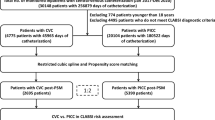Abstract
Objective
The objective of this study was to compare the relative number of complications from peripherally inserted central venous catheters (PICC) and centrally inserted central venous catheters (CVC) in the neuroscience intensive care unit (NSICU).
Methods
This study was carried out in a 32-bed NSICU in a large academic hospital in the USA from July 2015 until January 2017. Patients admitted requiring central venous access were randomly assigned to have a PICC or CVC inserted. Complications were recorded and compared. The primary outcome was all complications as well as combined numbers of large vein thrombosis, central-line-associated blood stream infections, and insertional trauma. Outcomes were compared using the Fisher’s exact test, logistic regression, or unpaired T tests, as appropriate.
Results
One hundred and fifty-two patients were enrolled; 72 were randomized to the PICC arm and 80 to the CVC arm. There were no crossovers, withdrawals, nor losses to follow-up. The study was stopped at the second pre-planned interim analysis for futility. The combined number of large vein thrombosis, central-line-associated blood stream infection, and insertional trauma was 4/72 in the PICC arm and 1/80 in the CVC group (OR 4.6 (95% CI 0.5–42.6) p = 0.14). The number of all complications in the PICC arm was 14/72 compared to 10/80 in the CVC arm (OR 1.7 (95% CI 0.7–4.1) p = 0.24).
Conclusions
PICCs and CVCs have similar numbers of complications when placed in patients admitted to the NSICU.

Similar content being viewed by others
References
Climo M, Diekema D, Warren DK, et al. Prevalence of the use of central venous access devices within and outside of the intensive care unit: results of a survey among hospitals in the prevention epicenter program of the Centers for Disease Control and Prevention. Infect Control Hosp Epidemiol. 2003;24(12):942–5.
Turcotte S, Dubé S, Beauchamp G. Peripherally inserted central venous catheters are not superior to central venous catheters in the acute care of surgical patients on the ward. World J Surg. 2006;30(8):1605–19.
Bonizzoli M, Batacchi S, Cianchi G, et al. Peripherally inserted central venous catheters and central venous catheters related thrombosis in post-critical patients. Intensive Care Med. 2011;37(2):284–9.
Wilson TJ, Stetler WR, Fletcher JJ. Comparison of catheter-related large vein thrombosis in centrally inserted versus peripherally inserted central venous lines in the neurological intensive care unit. Clin Neurol Neurosurg. 2013;115(7):879–82.
Bagwell CE, Salzberg AM, Sonnino RE, Haynes JH. Potentially lethal complications of central venous catheter placement. J Pediatr Surg. 2000;35(5):709–13.
Fletcher JJ, Stetler W, Wilson TJ. The clinical significance of peripherally inserted central venous catheter-related deep vein thrombosis. Neurocrit Care. 2011;15(3):454–60.
Wilson TJ, Brown DL, Meurer WJ, Stetler WR Jr, Wilkinson DA, Fletcher JJ. Risk factors associated with peripherally inserted central venous catheter-related large vein thrombosis in neurological intensive care patients. Intensive Care Med. 2012;38:272–8.
Mueller JT, Wright AJ, Fedraw LA, et al. Standardizing central line safety: lessons learned for physician leaders. Am J Med Qual. 2013;29:191–9.
Adachi YU, Sato S. Four cases of inadvertent arterial cannulation despite of ultrasound guidance. Am J Emerg Med. 2010;28(4):533.
Elliott TSJ, Faroquif MH, Armsbongs RF, Hanson GC. Guidelines for good practice catheterization in central venous and intensive. J Hosp Infect. 1994;28:163–76.
Fletcher JJ, Wilson TJ, Rajajee V, et al. A randomized trial of central venous catheter type and thrombosis in critically ill neurologic patients. Neurocrit Care. 2016;25(1):20–8.
Johansson E, Hammarskjöld F, Lundberg D, Arnlind MH. Advantages and disadvantages of peripherally inserted central venous catheters (PICC) compared to other central venous lines: a systematic review of the literature. Acta Oncol (Madr). 2013;52(5):886–92.
Al Raiy B, Fakih MG, Bryan-Nomides N, et al. Peripherally inserted central venous catheters in the acute care setting: a safe alternative to high-risk short-term central venous catheters. Am J Infect Control. 2010;38(2):149–53.
Jeong J-H, Bang J, Jeong W, et al. A dedicated neurological intensive care unit offers improved outcomes for patients with brain and spine injuries. J Intensive Care Med. 2017;34:104–8.
Skrifvars MB, Bailey M, Presneill J, et al. Venous thromboembolic events in critically ill traumatic brain injury patients. Intensive Care Med. 2017;43(3):419–28.
Dietch ZC, Edwards BL, Thames M, Shah PM, Williams MD, Sawyer RG. Rate of lower-extremity ultrasonography in trauma patients is associated with rate of deep venous thrombosis but not pulmonary embolism. Surgery. 2015;158(2):379–85.
Trerotola SO, Stavropoulos SW, Mondschein JI, et al. Triple-lumen peripherally inserted central catheter in patients in the critical care unit: prospective evaluation. Radiology. 2010;256(1):312–20.
French J, Gronseth G. Lost in a jungle of evidence: we need a compass. Neurology. 2008;71(20):1634–1638. https://doi.org/10.1212/01.wnl.0000336533.19610.1b.
Funding
Database software was funded by NIH/NCRR Grant Number UL1RR033184, the remainder of the study was departmentally/institutionally funded.
Author information
Authors and Affiliations
Contributions
NJB was involved in Protocol/Project Development, Data collection/management, Data analysis, Manuscript writing; JRD contributed to Project Development, data collection/management, manuscript editing; RP took part in Data collection, data analysis, manuscript editing; EPS was involved in Data collection, data analysis, manuscript editing; AH was involved in Data collection/management; AT was involved in Data collection/management; JW was involved in Data collection/management; SWH was involved in Data collection/management, protocol/project development, data analysis, manuscript editing/writing; JCZ was involved in Protocol/project development, data analysis, manuscript editing, project supervisor/Primary investigator.
Corresponding author
Ethics declarations
Conflict of interest
The authors declare that they have no conflict of interest to disclose.
Ethical approval/informed consent
This study was carried out with the approval of the institutional review board and in accordance with the 1964 Declaration of Helsinki. Informed consent was obtained for all participants in the research.
Additional information
Publisher's Note
Springer Nature remains neutral with regard to jurisdictional claims in published maps and institutional affiliations.
This study was carried out in accordance with the CONSORT standards and a checklist is provided.
Electronic supplementary material
Below is the link to the electronic supplementary material.
Rights and permissions
About this article
Cite this article
Brandmeir, N.J., Davanzo, J.R., Payne, R. et al. A Randomized Trial of Complications of Peripherally and Centrally Inserted Central Lines in the Neuro-Intensive Care Unit: Results of the NSPVC Trial. Neurocrit Care 32, 400–406 (2020). https://doi.org/10.1007/s12028-019-00843-z
Published:
Issue Date:
DOI: https://doi.org/10.1007/s12028-019-00843-z




